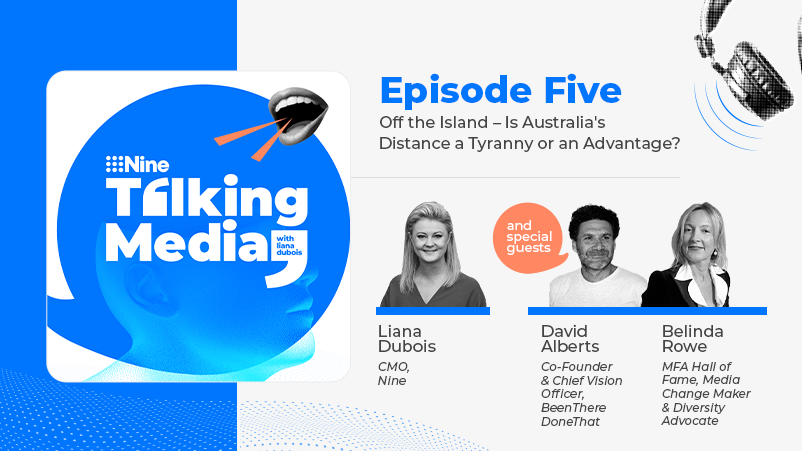Qantas set for financial hit as brand strength drops; Jetstar worse, Westpac, Macquarie struggling; negative revenue, pricing, growth impacts – but Optus recovering; Australia's 20 brands facing steepest strength declines
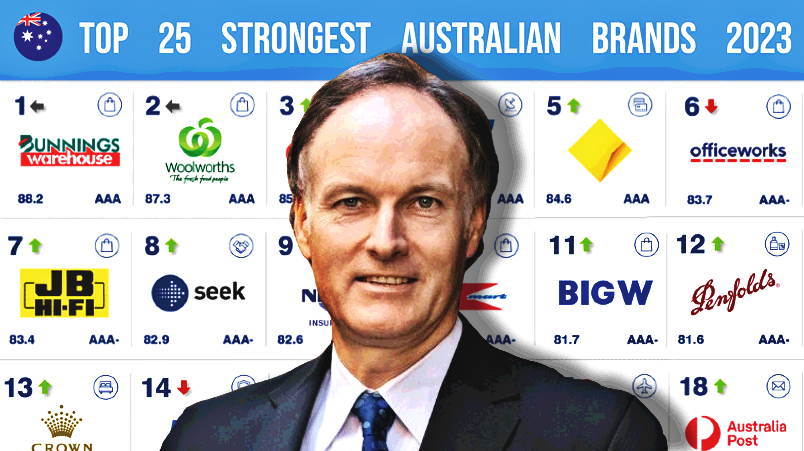
Brand Finance MD Mark Crowe: Declines in brand strength will have hard financial and negative growth impacts.
Some of Australia’s biggest brands across airlines, banking, retail and telco are set to take a financial hit due to underinvestment in marketing, innovation and customer service, leading to significant declines in brand strength and value, according to the world’s leading brand valuation firm. That will play out over the next year or so as they lose some of the network effects and efficiencies delivered by strong brands – including pricing power and ability to command higher premiums, customer acquisition and loyalty, recognition, consideration and recommendation, directly impacting revenue. The good news for strong brands is that previous investments insulate them from economic downturns and systemic shocks, according to Brand Finance MD Mark Crowe. Optus’ data hack could have been “catastrophic” for a weaker brand. But the telco is already recovering. He’s compiled the 20 Australian brands with the biggest declines in brand value and brand strength for Mi3.
What you need to know:
- Declines in brand strength signal incoming balance sheet impacts for brands including Qantas, Jetstar, Optus, TPG, Macquarie, Bega, Westfield, Fosters and David Jones, according to analysis by Brand Finance.
- The brand valuation firm has analysed current brand value, versus forward-looking indictors, which it classes as brand strength, compiling the 20 largest declines within both categories across its 100-strong index.
- Common factors are lack of investment; value for money; innovation and loyalty – with associated falls in brand recognition, consideration and recommendation. All of which translates to loss of future value.
- Optus took one of the biggest hits in brand strength and brand value – largely due to last year’s data hack. But Brand Finance MD Mark Crowe said the telco is already in recovery, with the strength of its brand shielding it from potentially “catastrophic” consequences.
- Bank of Queensland is facing major declines in brand strength, while Westpac-owned St George and BT Financial are also dropping. Crowe said diluting investment across three brands is hampering Westpac’s broader recovery from Royal Commission fallout compared to major rivals focused on single brands, such as Commbank, which is powering.
- He thinks converting brand value and strength scores into financial terms will help marketers convince investment committees to better value investment in brands.
- Brand value and health-focused KPIs are also starting to emerge within his client-base.
- Click on the tables below to enlarge the top 20 declines in both brand strength and brand value, per Brand Finance analysis, and the contributory factors.
Turbulence incoming
Brooding customer service angst around Qantas looks to set create a financial backlash sooner rather than later. The world’s leading brand valuation firm says the airline's brand value – a core part of intangible assets on the balance sheet – will likely take a hit next year based analysis of its brand strength.
But budget rival Jetstar is facing a far bigger decline, as are telcos Optus and TPG, while Bank of Queensland is set for the biggest fall of all in percentage terms, according to Brand Finance’s annual evaluation, with Macquarie riding its slipstream. Common factors? Lack of investment; value for money; innovation and loyalty – with associated falls in brand recognition, consideration and recommendation.
All of which translates to loss of future value, with Brand Finance MD Mark Crowe suggesting as much as 70 per cent of a company’s overall value is wrapped up in intangibles with brand a major component.
For the 20 brands of Australia’s 2023 top 100 that posted declines in brand strength, that translates to billions of dollars in value going up in smoke – with knock-on effects on pricing power, acquisition, retention and ultimately revenue and profit margin.
The challenge for marketers – as ever – is converting percentages into financial value with those holding investment purse strings. But Crowe suggests those that succeed are more likely to grow faster than their competitive set regardless of economic volatility. And for those in decline, there is heightened imperative.
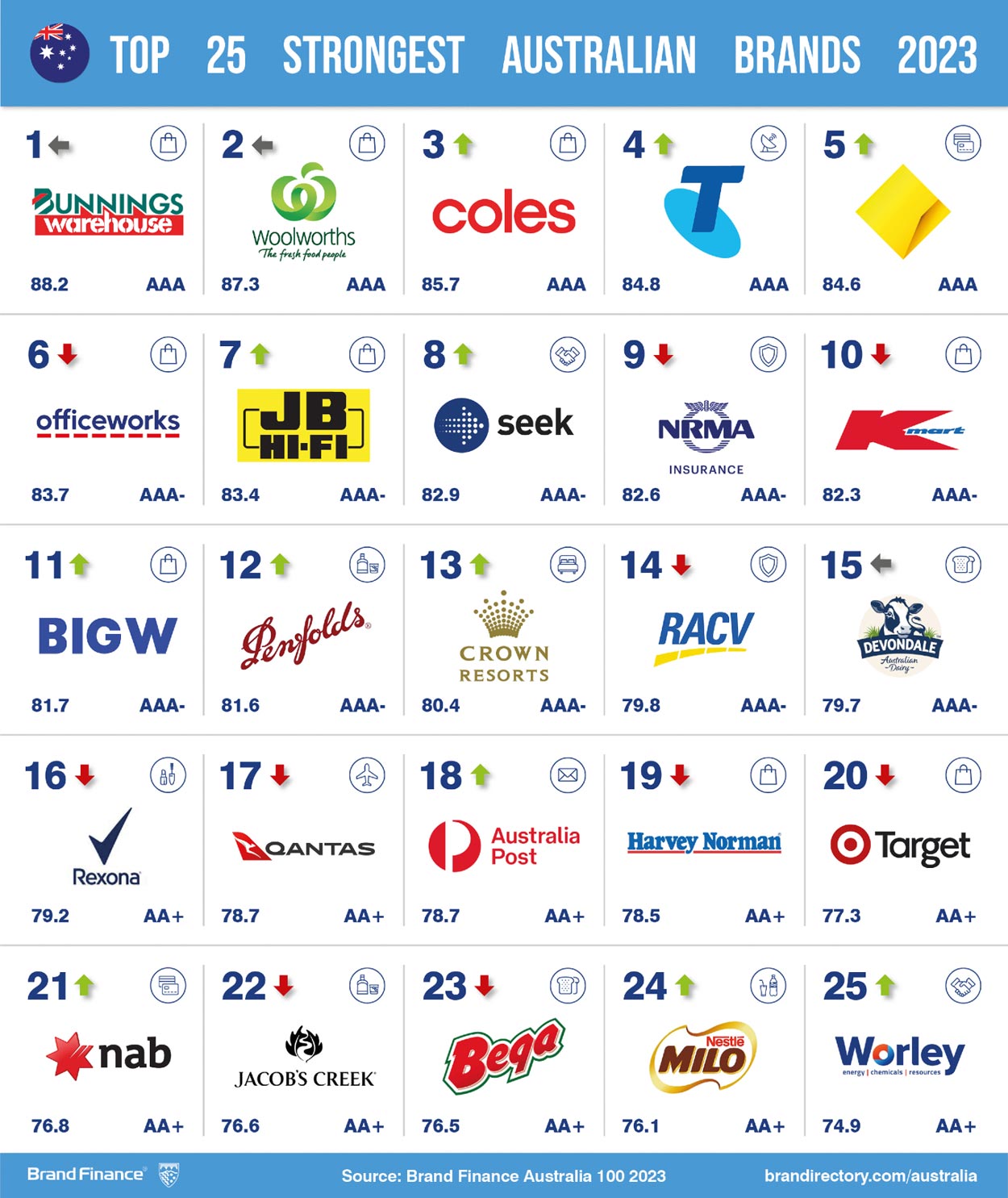
Brand value vs. brand strength
Brand Finance analyses brand and financial metrics to rank brands. This year it put Bunnings top of the pile in Australia for brand strength, followed by Woolworths, Coles, Telstra and Commbank. Within the top ten, three brands saw their strength decline year on year: Officeworks, NRMA and Kmart.
Crowe drilled down on the data for Mi3 to show the 20 biggest losers both across brand value and brand strength, the core metrics calculated to create its indexes.
Brand strength is a measure of three areas: The quality of investment in the brand, the equity the brand holds, and financial performance.
Brand value is a calculation of the economic benefits a brand brings to a business.
Below table: Brand Value top 20 declines
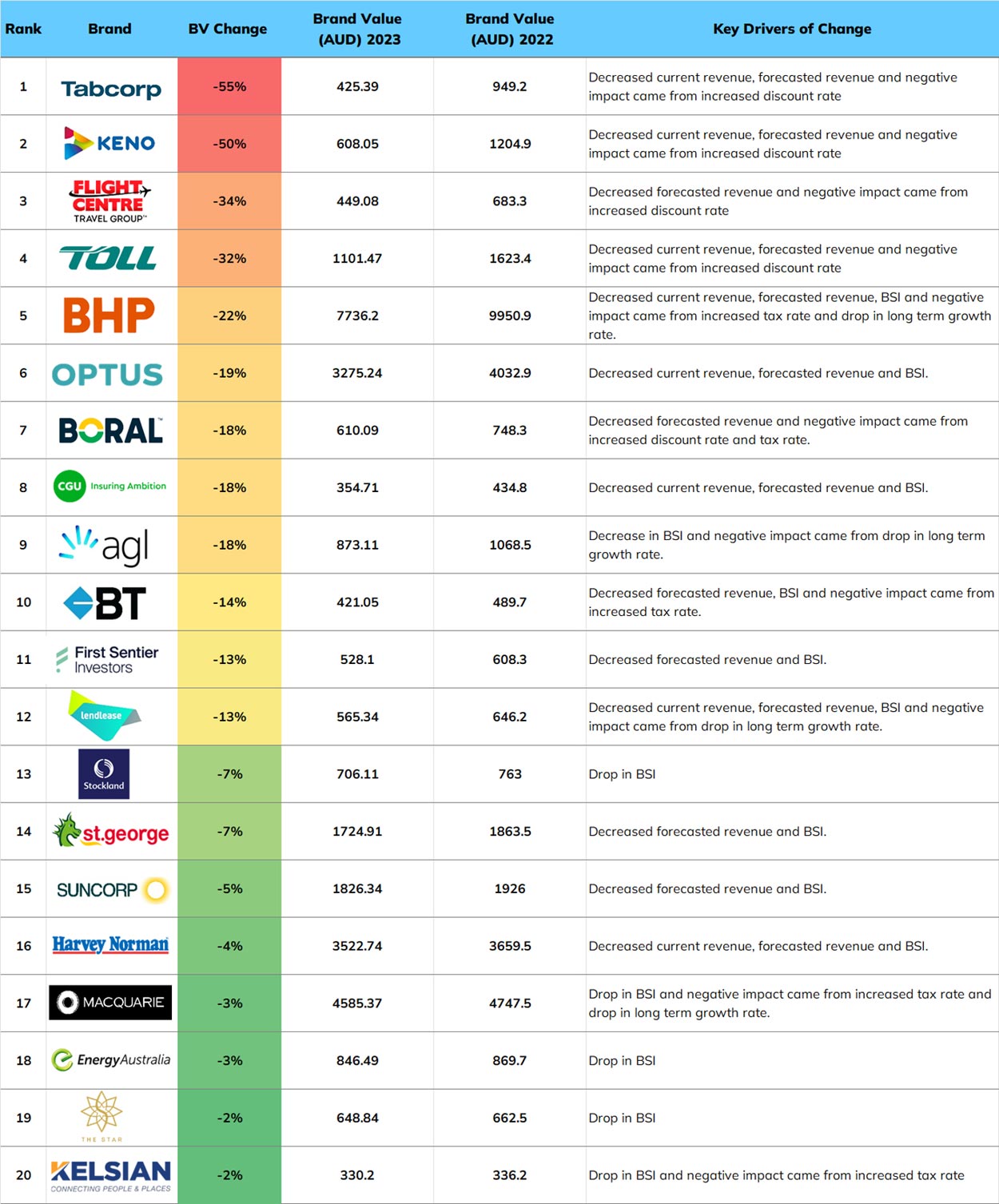
Brand value declines
Brand value scores evaluate a brand’s current value. Across the 100 brands analysed, Tabcorp and Keno have suffered the steepest declines, but that is due to the businesses last year demerging, leaving Flight Centre, with brand value down 34 percentage points year on year, per Brand Finance's calculations, the biggest loser in percentage terms.
Optus has lost almost a fifth of its brand value according to the rankings – partially due to its data breach fallout. But Crowe said its losses would have been far more costly without the shielding effect of a strong brand to start with. Optus, per Crowe, has already started to recover.
Brand strength declines: Qantas vs. Jetstar
Brand strength scores indicate where brands are headed: Declining brand strength suggests incoming declines in brand value – and therefore weaker future growth prospects with impacts more keenly felt during the current economic crunch.
Qantas’s brand value actually increased over the last year. But its brand strength – the forward-looking aspect – declined by 4.3 percentage points, “so that's a forewarning in terms of where are they heading,” Crowe told Mi3.
“They've taken a significant hit to brand strength. And that's a challenge for Qantas because, yes, we're all getting back to some level of normalcy when it comes to travel, but across some key attributes, they've taken a hit. And if they can't arrest that, then that's going to start to open it up.”
Brand Finance lists the reasons for decline as falls in brand investment and equity, brand loyalty and – perhaps unsurprisingly, value for money (see tables – click to enlarge).
But Jetstar’s brand strength has fallen by 8.9 percentage points, more than double its larger rival, for almost all the same reasons.
Below table: Brand strength top 20 declines
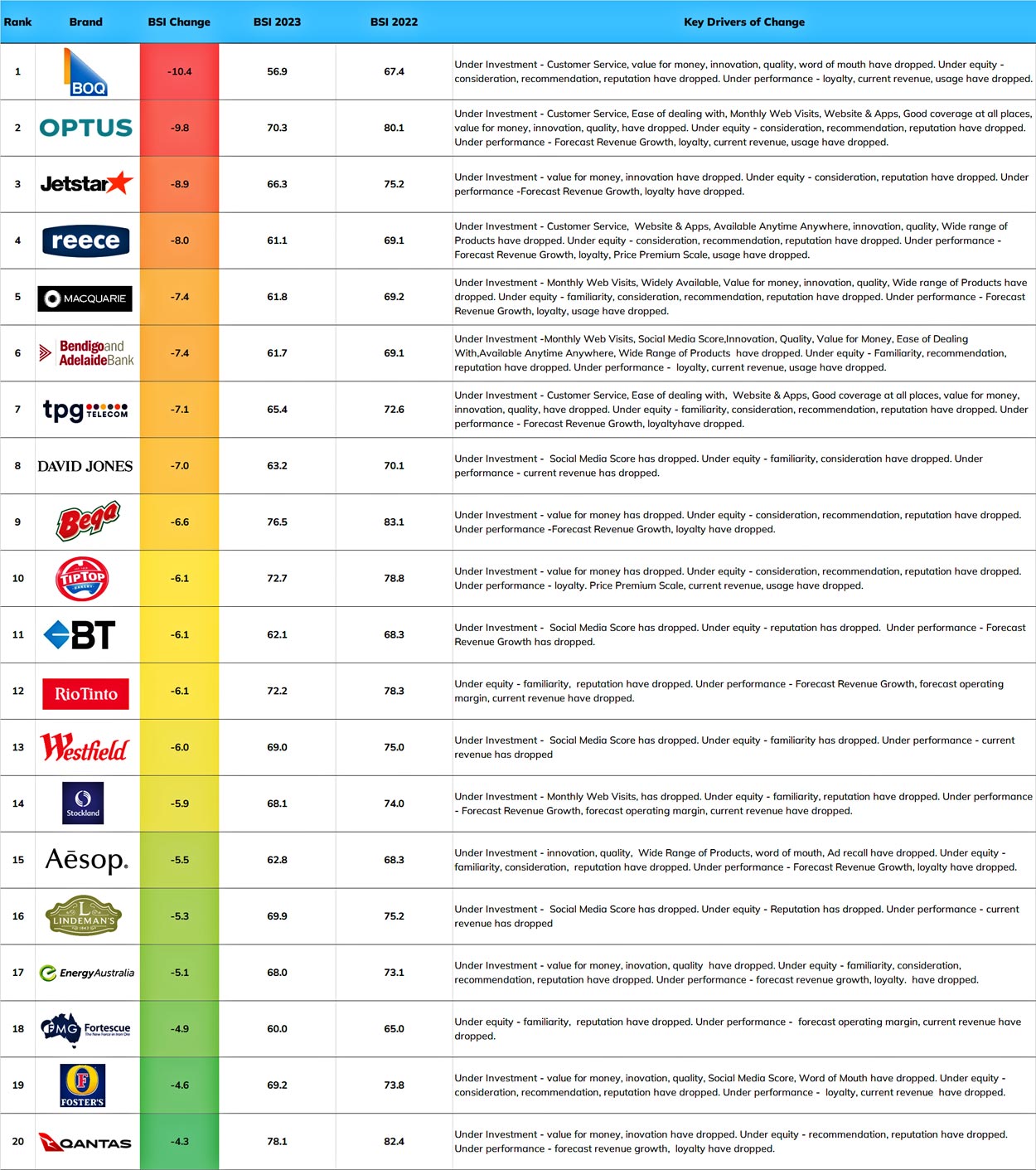
Commbank rises, Westpac falls
Westpac-owned BT Financial and St George, plus Suncorp and Macquarie all notched brand value declines.
Within brand strength rankings, BT Financial posted the eleventh largest decline, Macquarie and Bendigo and Adelaide bank were the fifth and sixth biggest losers, with Bank of Queensland bottom of the pile.
Westpac also posted brand strength declines, which “is not a one-off event”, according to Crowe.
“We’ve seen that decline over the last two to three years. Coming out of a challenging period for the category following the Royal Commission, Westpac is not getting the bounce that the other three of the top four are enjoying. Westpac is certainly struggling in terms of turning it around,” said Crowe.
He thinks the group’s fragmented brand architecture – spanning Westpac, BT and St George – is a limiting factor.
“From a brand investment point of view, the more you have, the more challenges there are to manage – and they are very distinct assets … which can lead to dilution of effectiveness. Whereas CBA is investing into the one Commbank brand.”
Within the top 25 strongest brands index, Commbank and NAB posted gains.
Telstra rises, Optus declines (but in recovery)
Optus’ brand strength and value declines can be largely isolated to the cyber attack. Without it, said Crowe, “Optus would have enjoyed an 11 per cent increase in brand value. If you take away that incident, Optus would have enjoyed a strong year from a brand strength point of view. They would in fact be a top ten strong brand and their brand value certainly would have been a lot higher as well.” However, the Singtel-owned telco’s revenues, revised downwards, also affected its index ranking.
Optus’ woes have come as Telstra has broken back into the top ten rankings for brand strength, powering to number four. Crowe thinks that telcos diversifying into media, subscriptions and beyond may fuel an upward trend, though TPG saw brand strength declines of 7.1 percentage points on the index.
“They're trying to grow outside of their category, make the brand bigger than what category restraints may be imposing. For a successful brand, you want to do that. You want to be more than just another brand in a particular category.”
Strong brands withstand shock
Post-hack, Crowe sees signs that “Optus is already recovering well”, with long-term brand investment shielding it from potentially terminal damage. That echoes the view of former Optus CMO, Mel Hopkins, who told Mi3 that the recovery will take months rather than years, though Crowe thinks there is still some way to regain pre-hack strength.
“Optus has traditionally been a strong brand, it has done well on trust and the brand [strength] is driving the recovery. If that cyber attack was on a much weaker brand, the result could have been catastrophic, the business may have failed,” per Crowe.
“People often think of brands for the good times. But when there is a hit on reputation, whether that is fair or unfair, it's the ability of the brand to drive that recovery. What we're seeing with Optus remains at an early stage, because that attack is still relatively recent. But we are seeing improvement across those key attributes which ultimately will determine where Optus stands next year.”
Crowe said the same rules apply to brands navigating the current economic cycle – and as ever, bigger, stronger brands tend to enjoy greater protection than smaller or weaker rivals.
“Strong brands in an uncertain economic environment can deliver two things that become more difficult for weaker brands or brands that are still challenging: they offer assurance and they tend to strengthen in terms of navigational pull,” said Crowe.
“People look for certainty and that will often lead them to the stronger brand. So what this Australia 100 [brand strength index] is pointing to … is that a lot of businesses that are highly branded will be fortified against variable economic conditions. Also, a lot of the recovery will be very much brand-driven.”
Internal marketing, ESG matters
Internal marketing – how companies are viewed by “employees, stakeholders and suppliers” – is increasingly a factor in brand strength rankings, per Crowe.
“People are very much influenced by the brand they're working for. They are mindful of how strong that brand is and how well that may reflect, as people want to say these days, on their own brand.”
While brands are nervous about making missteps on ESG claims, given increased regulatory scrutiny this year, both internal marketing and external positioning for talent attraction is driving “the whole corporate social responsibility movement”, according to Crowe.
“People may have varying views as to how important [ESG positioning] is, but just have a look at brand advertising, how much they're pointing to their green credentials. It's across the board. They're not doing that because it's necessarily making money in the first instance. They're doing it because they know that they are being marked on that – and they're not dumb.”
Brand value KPIs incoming?
Crowe, a former Australian Marketing Institute CEO, thinks more marketers and their suppliers – i.e. agencies – may benefit from having KPIs linked directly to brand value and strength, given the links to current and future revenue performance.
Some of Brand Finance’s clients have already moved to those kind of KPIs, which Crowe said hold more weight if percentage gains in brand strength and value are articulated in hard dollar terms – in much the same way that brand is valued in M&A transactions (though ironically often undervalued post-transaction).
“What do those percentages mean for us if they're realised in a dollar sense? That's in many respects what a brand valuation is able to achieve,” said Crowe. “It's really converting a financial lens around marketing contribution and effectiveness.”
But even preventing brand strength and value declines is a result in itself, according to Crowe.
“If you maintain the value and the brand is doing its job within the business, then you're doing a good job. If you can then grow the value of the brand, you're putting in place even greater long-term sustainability.”



